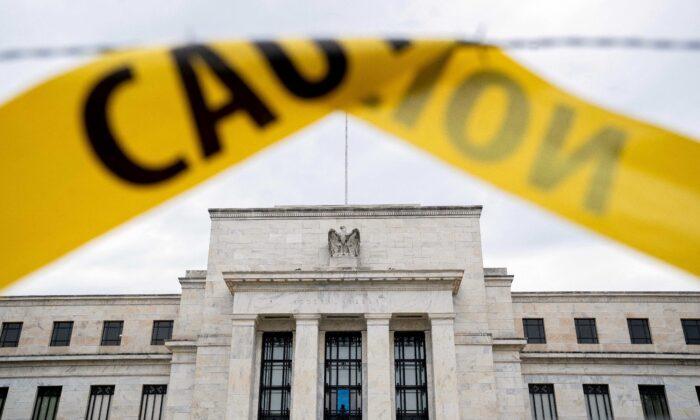Commentary
Old habits die hard for the folks over at the Federal Reserve, who immediately rung in the 2023 financial crisis with what will in due time be recalled as the fifth round of quantitative easing, the Fed’s preferred term for monetary expansion.
It’s now apparent that the Fed currently finds itself between a proverbial inflation rock and a recession hard place. Such is the lot of an economy brimming with cheap paper when the inflation chickens come home to roost and monetary austerity is required.
Until last week, the Fed appeared resolute in its commitment to defeating inflation by every means necessary.
The Fed was even widely criticized for being too resolute, with commentators across the political spectrum voicing concerns over the speed at which interest rates were normalizing.
The point of raising interest rates is to incentivize saving over consuming, which seems prudent in the context of
6 percent official inflation and a
near record-low personal savings rate. More saving, in turn, should slow inflation. The point of raising rates isn’t to raise unemployment or cause a recession, as Keynesian ideologues sometimes misguidedly suggest, but these are indeed common side effects of contractionary monetary policy.
Of course, the economists at our central bank know this and so should’ve been prepared to endure some economic pain as a result of the righteous inflation fight they so unwaveringly chose. Apparently, they weren’t.
In hindsight, it was relatively easy for the Fed to project false resolve as the
labor market remained robust and
GDP positive. But as soon as the first shoe dropped, in the form of a major bank failure, namely the poorly managed,
rate-sensitive Silicon Valley Bank (SVB), the Fed didn’t await a second, though Signature Bank quickly collapsed as well. As federal regulators from the Federal Deposit Insurance Corporation (FDIC) stepped in to take control of SVB, guarantee all uninsured deposits, and initiate an auction program, Fed officials prepared a new program of their own to help stanch the bleeding.
Essentially, the government is offering cheap loans for any reason to any FDIC-insured American bank or American branch of a foreign bank that wants to post their government securities as collateral. But there’s one unique key feature of the new program: It allows underwater assets to be collateralized at the full par value they wouldn’t otherwise realize until maturity, often years in the future. So the Fed is restarting the money printers to allow financial institutions to leverage up on more cheap credit. Make no mistake: This is a relapse on the monetary heroin that got us into this mess in the first place.
It’s precisely cheap credit that’s responsible for cash-flush tech companies pouring their capital into SVB and driving unsustainable 300 percent
deposit growth since 2018. It’s cheap credit that has fueled the record inflation currently eroding Americans’ purchasing power. And it’s cheap credit-induced inflation that necessitated the interest rate hikes that destroyed the value of SVB’s bond portfolio, causing the bank to go under.
Some suggest that these backstop programs are necessary to save the thousands of small businesses that banked with SVB et al. However, the candor of such sentiment is questionable at best as Ma and Pa prepare to facilitate the de facto
bailout of Roku, which kept $487 million at SVB,
California Gov. Gavin Newsom, whose several wine companies banked at the now-failed institution, and countless other wealthy individuals and corporations alike.
According to President Joe Biden, the taxpayer will not be on the hook for any of the cost of these depositor bailouts. Setting aside the fact that the FDIC is funded by Main Street bank depositors–taxpayers–that’s still disingenuous.
But the more explicit taxpayer bailout goes back to the Fed and its BTFP. The central bank that was just weeks ago feigning resolve in its war on your rising grocery bills has now pivoted–quietly, but decidedly.
As banks have rushed to take advantage of new liberal lending programs such as the BTFP, the
Fed’s balance sheet has once again begun to grow—to the tune of $300 billion–reversing four months of quantitative tightening in just one week.
According to JP Morgan, the BTFP may ultimately inject up to $2 trillion in new liquidity into the financial system.
So quantitative easing is back, albeit under a different name. But then again, quantitative easing itself is simply the choice alias for government inflation. It remains to be seen whether Jerome Powell and his crew will continue raising rates even as the balance sheet grows. But what’s perfectly clear is that our mighty Federal Reserve was but a mere paper tiger—or rather, a paper hawk. Things started breaking, and so went the Fed.
Welcome to QE5.
Views expressed in this article are opinions of the author and do not necessarily reflect the views of The Epoch Times.
